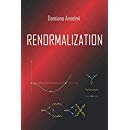Papers
Here are all papers published on Renormalization.COM
A more compact single-page list can be found at this link
We investigate the background field method with the Batalin-Vilkovisky formalism, to generalize known results, study parametric completeness and achieve a better understanding of several properties. In particular, we study renormalization and gauge dependence to all orders. Switching between the background field approach and the usual approach by means of canonical transformations, we prove parametric completeness without making use of cohomological theorems, namely show that if the starting classical action is sufficiently general all divergences can be subtracted by means of parameter redefinitions and canonical transformations. Our approach applies to renormalizable and non-renormalizable theories that are manifestly free of gauge anomalies and satisfy the following assumptions: the gauge algebra is irreducible and closes off shell, the gauge transformations are linear functions of the fields, and closure is field-independent. Yang-Mills theories and quantum gravity in arbitrary dimensions are included, as well as effective and higher-derivative versions of them, but several other theories, such as supergravity, are left out.
Phys. Rev. D 89 (2014) 045004 | DOI: 10.1103/PhysRevD.89.045004
The classical action of quantum gravity, determined by renormalization, contains infinitely many independent couplings and can be expressed in different perturbatively equivalent ways. We organize it in a convenient form, which is based on invariants constructed with the Weyl tensor. We show that the FLRW metrics are exact solutions of the field equations in arbitrary dimensions, and so are all locally conformally flat solutions of the Einstein equations. Moreover, expanding the metric tensor around locally conformally flat backgrounds the quadratic part of the action is free of higher derivatives. Black-hole solutions of Schwarzschild and Kerr type are modified in a non-trivial way. We work out the first corrections to their metrics and study their properties.
JHEP 1305 (2013) 028 | DOI: 10.1007/JHEP05(2013)028
We study phenomena predicted by a renormalizable, CPT invariant extension of the Standard Model that contains higher-dimensional operators and violates Lorentz symmetry explicitly at energies greater than some scale $\Lambda_{L}$. In particular, we consider the Cherenkov radiation in vacuo. In a rather general class of dispersion relations, there exists an energy threshold above which radiation is emitted. The threshold is enhanced in composite particles by a sort of kinematic screening mechanism. We study the energy loss and compare the predictions of our model with known experimental bounds on Lorentz violating parameters and observations of ultrahigh-energy cosmic rays. We argue that the scale of Lorentz violation $\Lambda_{L}$ (with preserved CPT invariance) can be smaller than the Planck scale, actually as small as $10^{14}$-$10^{15}$ GeV. Our model also predicts the Cherenkov radiation of neutral particles.
Phys. Rev. D 83 (2011) 056010 | DOI: 10.1103/PhysRevD.83.056010
We consider renormalizable Standard-Model extensions that violate Lorentz symmetry at high energies, but preserve CPT, and do not contain elementary scalar fields. A Nambu–Jona-Lasinio mechanism gives masses to fermions and gauge bosons, and generates composite Higgs fields at low energies. We study the effective potential at the leading order of the large-$N_{c}$ expansion, prove that there exists a broken phase and study the phase space. In general, the minimum may break invariance under boosts, rotations and CPT, but we give evidence that there exists a Lorentz invariant phase. We study the spectrum of composite bosons and the low-energy theory in the Lorentz phase. Our approach predicts relations among the parameters of the low-energy theory. We find that such relations are compatible with the experimental data, within theoretical errors. We also study the mixing among generations, the emergence of the CKM matrix and neutrino oscillations.
Phys. Rev. D83 (2011) 056005 | DOI: 10.1103/PhysRevD.83.056005

 Quantum Gravity
Quantum Gravity 


